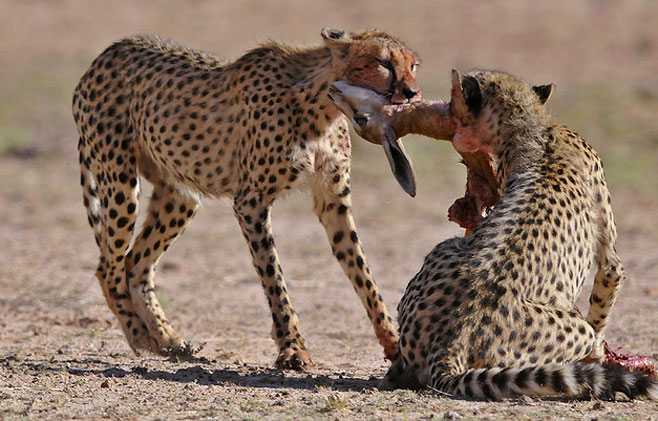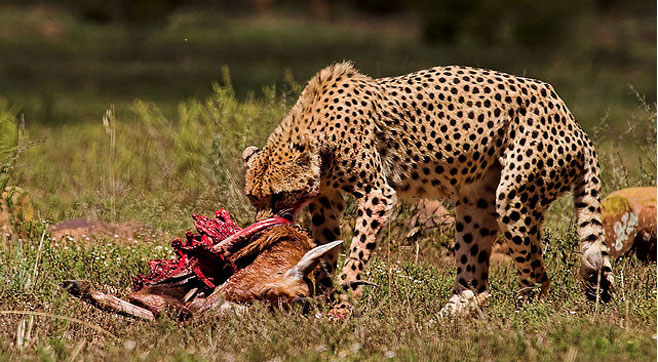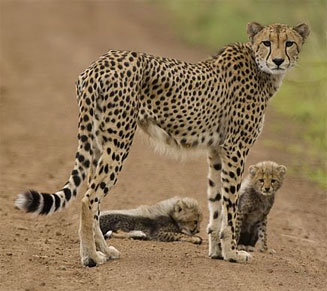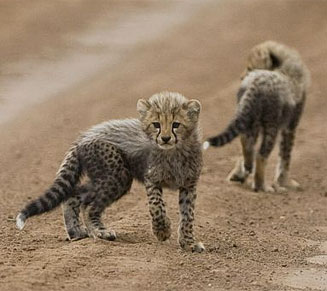|
Acinonyx jubatus (Cheetah)
jagluiperd [Afrikaans]; Gepard [German]; guepard [French]; duma, msongo
[Swahili]; i;hlosi [isiNdebele] [isiXhosa]; ihlosi, ingulule [isiZulu]; lengau,
lepôgô, nkwê-'silo [Sepedi]; lengau [Sesotho] [Setswana]; dindingwe, ihlosi [Shona];
sinkankanka, lihlosi [siSwati]; ndloti, xinkankanka [Xitsongo]; didinngwe,
dagaladzhie [Tshivenda]; linau [Lozi]; unqaba [Yei]; !Amb [Nama] [Damara]; shitona
[Herero]; shinga [Ovambo]
Life
>
Eukaryotes >
Opisthokonta >
Metazoa (animals) > Bilateria > Deuterostomia >
Chordata > Craniata > Vertebrata (vertebrates) >
Gnathostomata (jawed vertebrates) > Teleostomi (teleost
fish) > Osteichthyes (bony fish) > Class:
Sarcopterygii (lobe-finned fish) > Stegocephalia
(terrestrial vertebrates) > Reptiliomorpha > Amniota >
Synapsida (mammal-like reptiles) > Therapsida > Theriodontia
> Cynodontia > Mammalia (mammals)
> Placentalia (placental mammals) > Laurasiatheria
> Ferungulata > Ferae > Carnivora > Family:
Felidae (cats) > Subfamily: Acinonychinae
Hunts down prey (mainly antelope) by chasing it
at high speed over short distances. Its running speed is such that
it holds the record as the fastest land mammal, being able to run in
excess of 70 km/h. Females hold territories and do all the work in
rearing the young. Males are nomadic.
Identification
The cheetah is the fastest land mammal,
referred to as the “greyhound of cats”. It resembles these dogs with
its slender build, long legs and long tail. The head is rounded with
a short muzzle. The coat dotted with solid black, round spots. A
clear black line, the “tear-mark”, runs from the inner corner of the
eye to the corner of the mouth. The long tail is black-ringed with a
white tip. A short crest of erectile hair is situated on the back
and sides.
The cheetah is the only member of the cat
family that does not have fully retractable claws. The imprint of
the claws can be clearly seen in their tracks.
Size
Body length 180 – 220 cm; Height at
shoulder 80 cm ; weight range 40 -60 kg.
Dental formula
I C C P P M M =
30 =
30
Distribution and habitat
Africa and the Middle East. Occur in open savanna and occasional light
woodland.
In Asia cheetah used to be tamed and used for
hunting, particularly the very fast black buck.
General behaviour
Cheetah are normally solitary or seen in small
family groups consisting of a female and her young or a bachelor
group of young males. Female
cheetahs hold and defend territories from other females, but the
males appear to be nomadic.
Hunting and food
Cheetahs are diurnal, but are usually active
during the cooler parts of the day. The hunt involves stalking to
within a short distance of the intended prey and then sprinting in
for the kill. Although they can reach speeds in excess of 70k/h,
they can only maintain top speed for a few hundred metres. Their
hunting success is not particularly high with only about a third of
all attempts resulting in a kill. Cheetahs are also often chased
from their kills by other predators and scavengers, so they eat
quickly after a kill. Typically cheetahs will seek a viewpoint, (a
rock, tree, or mound) to scan the savanna for potential prey.
Food includes medium sized mammals, usually
antelope.
They also catch birds up to the size of
ostrich.
 |
|
Two young Cheetahs feeding on their Springbok
prey, Mata Mata Road, Kruger National Park, South Africa. [photo
Callie de Wet ©] |
 |
|
Cheetah feeding on a carcass, Bloemfontein, South
Africa. [photo Gerhard Theron
©] |
 |
|
Cheetah chasing down a Springbok, Kgalagadi
National Park, South Africa. [photo Coke
Smith
©] |
Reproduction
The gestation period lasts 90-95 days. Litters
usually consist of 3 cubs and the mother is solely responsible for
raising them. She has to hunt to feed her family and also train the
cubs in the skills of hunting once they are old enough. At this
stage she will bring suitable prey back to her offspring and release
it for them to catch again. Male cheetah are aggressive to cubs and
juveniles and their mothers take great care to protect them from
encountering this type of danger. For the first 6 weeks of their
lives the cubs are hidden in dense plant cover, after this period
they will follow their mother.
 |
 |
|
Cheetah with cubs, Phinda Game Reserve, South
Africa. [photos Trevor Hardaker ©] |
Life span
About 12 years; 17 years in captivity
Conservation
Cheetah are endangered throughout their
range. This is a result of habitat destruction, elimination of their
natural antelope prey by humans and direct persecution. It is
thought that 5000 –15 000 cheetah may remain in Africa. As few as
200 may remain in the Middle East where it is critically endangered.
Overall, its Red List status is classified as Vulnerable (click on
link to IUCN below).
Links
Text by Denise Hamerton |
